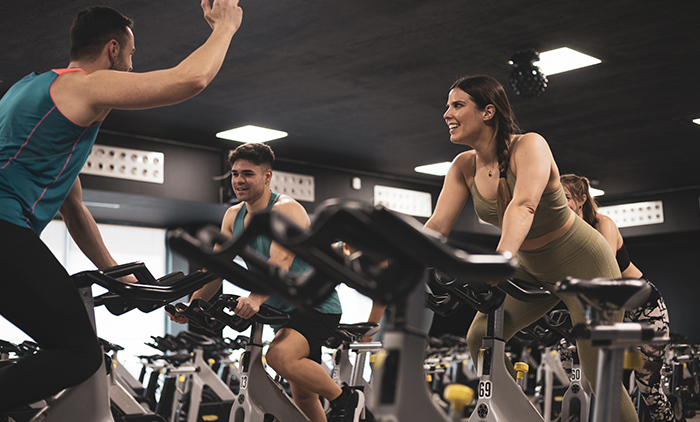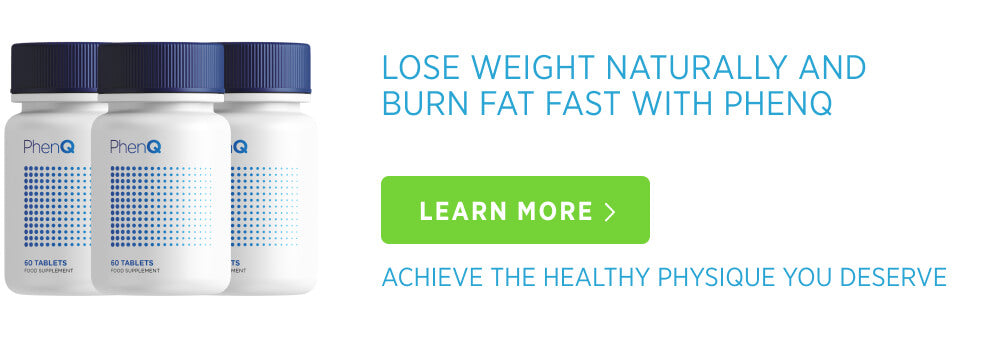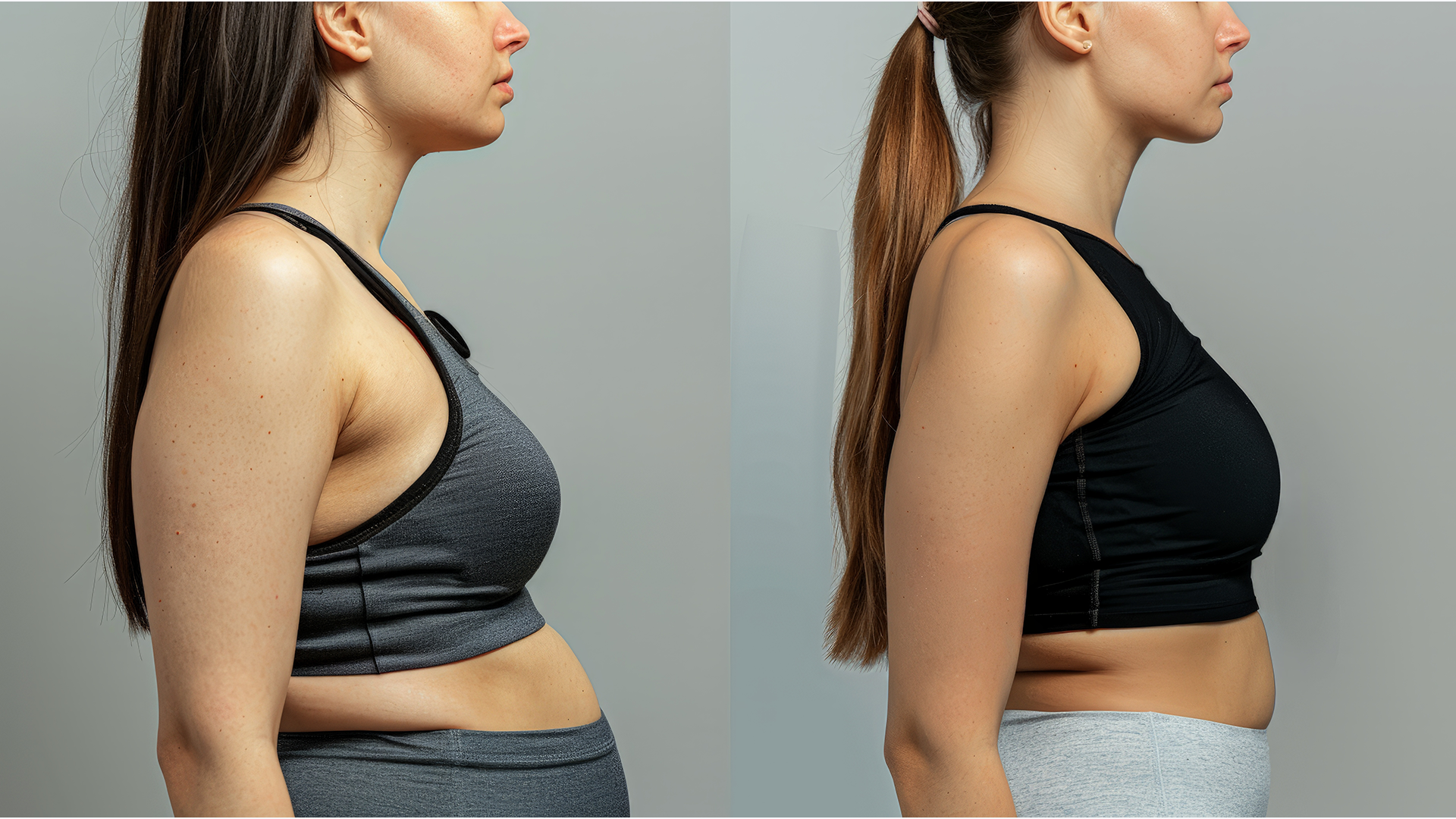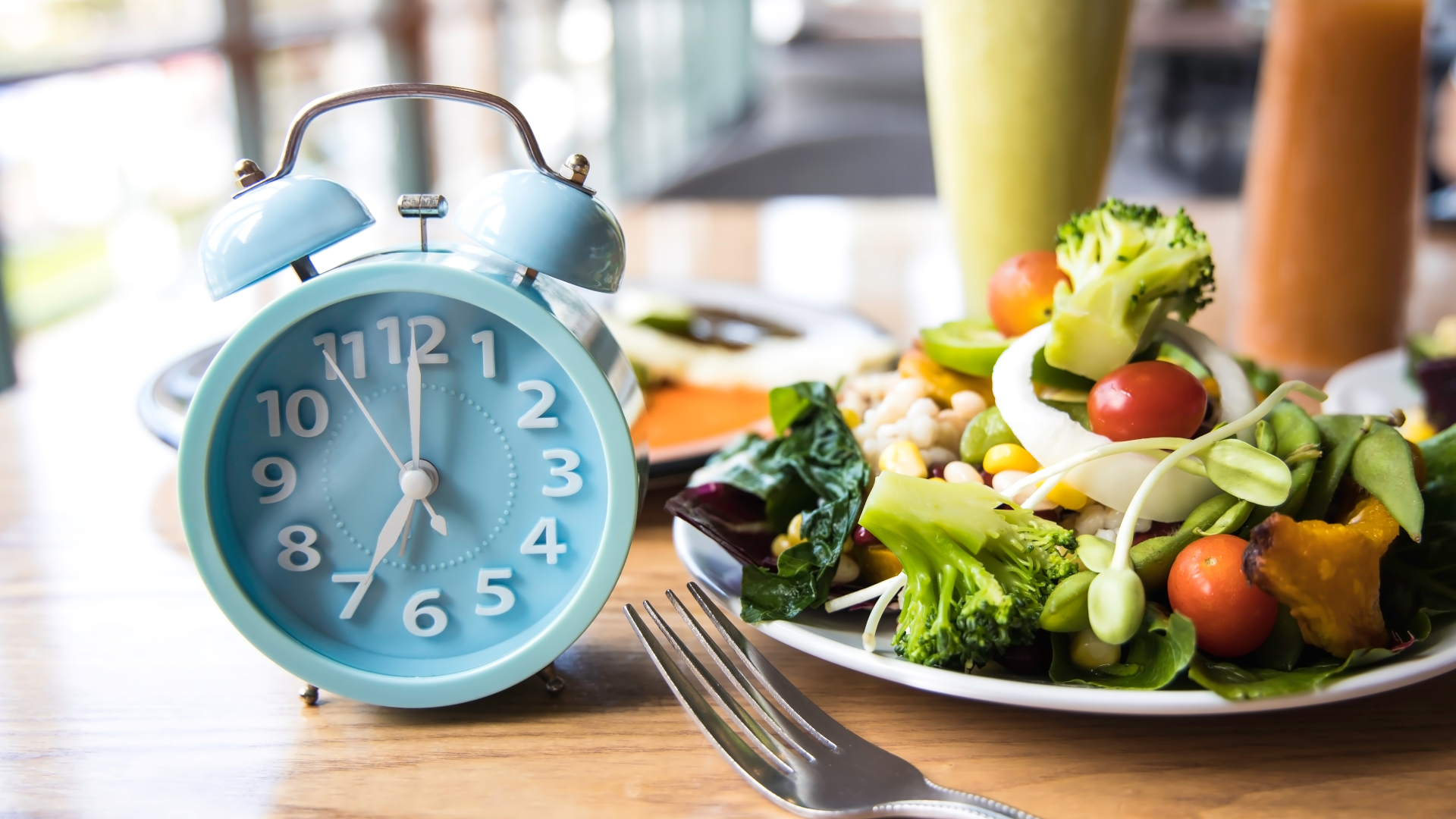A military-style personal trainer screaming in your face, muscles burning, sweat dripping, and your heart beating at 100 miles an hour. It’s likely you’ve imagined (and feared) a similar high-intensity scenario when thinking about an exercise routine.
And let’s face it, it’s not the most welcoming of experiences - especially if you're new to the gym or it’s a while since you’ve been.
The thought of exercising til you drop - it’s tiring just thinking about it.
And luckily, fitness professionals agree that it’s not the only way to achieve your fitness goals.
The key is to create a fitness routine that pushes you toward your goals while working alongside your abilities and lifestyle.
Intensity is one of the variables that you can alter to help you reach your fitness goals.
So, in this blog, we’re exploring the differences between high-intensity and low-intensity exercise, so you can figure out which one to include in your routine.
Why is exercise intensity important?

Exercise intensity refers to the amount of oomph or effort you put into your workout. Like the military-style Bootcamp, many people think that working their body to exhaustion is the best way to exercise.
But it’s not always the case - and in fact, it could be detrimental to your overall progress.
The intensity that you exercise needs to be considered as it impacts your:
- Recovery
- Sustainability
- Overall goals
You physically cannot work out at maximum capacity every single day. Your muscles (and your mind) need time to recover, and the intensity you exercise will impact how long this takes.
A high-intensity workout might leave your muscles aching and will take a couple of days to recover from. Whereas a low-impact workout will have minimal recovery time.
Plus, pushing yourself to the limit (for most people) isn’t sustainable. You’ve got friends, family, a job, and life - so you need to balance exercise alongside all the things that matter to you.
And ultimately, your exercise intensity will impact how quickly you reach your goals. If you’re serious about working out, it’s useful to know about exercise intensity. It’s just one way to manipulate your training sessions so you can keep making progress by encouraging your body to adapt.
For most people, it’s about understanding the difference and then striking a balance between the two.
How do you measure exercise intensity?
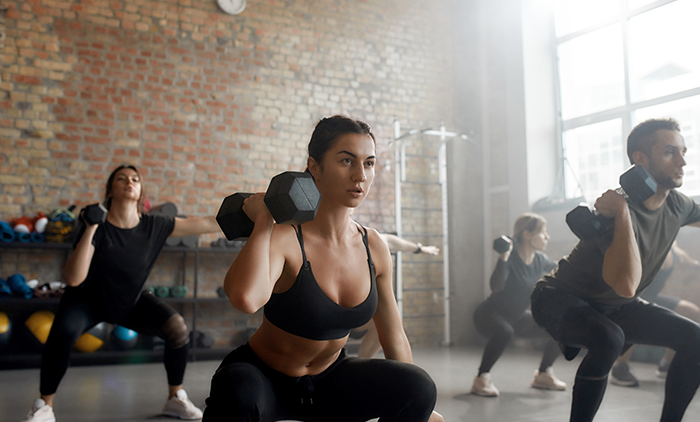
The intensity of exercise is subjective, so how hard something feels will depend on each individual person. And because of this subjectivity, it’s not the easiest element of exercise to measure.
For example, a game of leisurely tennis with a friend might feel exhausting for you - but for Serena Williams, it would feel like a walk in the park.
So, one of the easiest (and most accurate) ways of measuring intensity is to go on how you feel during the workout. Generally speaking the harder it feels, the higher the exercise intensity. And this way allows you to adapt your workouts to your own personal tolerance.
How to measure your maximum heart rate…
Another way to measure exercise intensity is via heart rate, as intensity is often expressed as a % of maximum heart rate.
But what does that mean?
Your maximum heart rate is the highest number of beats per minute your heart should pump when it’s under stress (ie. exercising). You can work this out by subtracting your age from 220.
So, for example, if you are 35, then your maximum heart rate is 220 - 35 = 185 beats per minute.
Within this, you’ll have a target heart rate, which is expressed as a % of your max heart rate, and this % will vary depending on the exercise intensity.
For example, moderate exercise is between 50-70% of your maximum heart rate. Which, for a 35-year-old would be approximately 92 - 129 beats per minute.
You can measure your heart rate using a wearable device, although these are known for being inaccurate, so use this as a guideline only. You can also measure your heart manually by counting your pulse (this might be a little tricky while exercising).
While it’s not the most accurate measurement, understanding the intensity of your exercise will help you adapt and progress toward your goals.
High-intensity exercise vs low-intensity exercise: what are they?
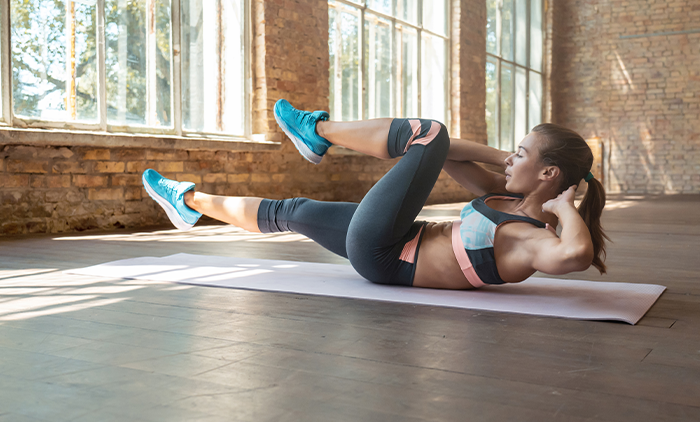
The best way to explain high and low intensity is to compare them to each other. Imagine the difference between a slow walk and an all-out sprint. That’s an extreme example of changing exercise intensity, and the level of exertion that goes along with each.
Not only do they look different, but they have different advantages and disadvantages, that make them suitable for different people, or at different points in a training program.
What is high-intensity training (HIT)?
High-intensity training or HIT as it’s more commonly known is the overarching term for short bursts of intense exercise alternated with recovery intervals.
It usually involves pushing yourself close to your limits for short periods of time, with your heart rate around 70-85% of your max, followed by recovery periods. This is usually repeated multiple times for around 20-30 minutes.
It adds extreme stress to your metabolism and muscle tissues, which are working at near maximum capacity. This is the type of exercise that you put your all into - there isn’t any chatting with your gym friends during a HIT workout.
There are a couple of terms that you might be more familiar with that fall under HIT:
-
HIIT (High-intensity interval training): a short period of strenuous physical conditioning, followed by a period of rest
- HIIRT (High-intensity interval resistance training): also a short burst of vigorous physical activity, but using resistance training
You might also hear HIIT or HIIRT referred to as interval training, as it involves performing for intervals.
Most people use a combination of conditioning and resistance-based high-intensity interval training, depending on their lifestyle (and what they prefer).
Maybe you love running but break into a cold sweat at the sight of kettlebells (or vice versa). Either way, you can incorporate HIIRT or HIIT workouts into your routine, while still making it enjoyable and in keeping with your lifestyle.
Related content: The smart dieter's guide to HIIT workouts for fat loss

Examples of high-intensity workouts…
So, what does a HIT workout look like? Here are some examples:
- Running (jogging or sprinting)
- Rowing machine
- Spin class
- Jump rope training
- Tabata training
- Kettlebell workouts
- CrossFit WODs
- Circuits class
- Bootcamp
- Dance class
- Hillwalking
These are just guidelines, as what is high-intensity for one person might be easy for another and vice versa.
The benefits of HIT workouts…
High-intensity exercise is, as the name suggests, intense - it takes a lot of effort and energy. But in return, there are loads of physical health benefits including
- Lowers high blood pressure
- Increases cardiovascular fitness
- Lower cholesterol
- Increased muscle mass
- Burns more calories
- Builds lean muscle mass
- Improves bone density
One of the main benefits of HIIT exercise, is that it’s fast - you only need 20-30 minutes for a full workout. And if you are doing it right you physically shouldn’t be able to work out for more than 30 minutes.
This means you get a lot more bang for your buck in comparison to low-intensity, making it ideal for busy people who are low on time and want to get their workout over and done with.
The disadvantages of HIT workouts…
HIT workouts are an amazing way of getting fit and burning calories, but there are some limitations to them:
- Longer recovery time
- Maximum 30-minute workout
- Higher risk of injury
None of these things makes HIT workouts bad. Rather the very nature of pushing your body to the limit means it’s going to deplete your energy faster - so you need to make sure you give yourself time to recover.

What is Low-Intensity training (LIT)?
Low-intensity exercise is best described as a physical activity performed at a comfortable pace and prioritizes movement, rather than sweating and exhaustion.
Your target heart rate should stay around 50% of your maximum heart rate - so while you might feel a little bit out of breath, you’ll still be able to hold a conversation.
One type of low-intensity workout is LISS, which stands for low-intensity steady state. This training style is almost the exact opposite of HIT and involves cardio activity at a very low intensity for a longer period of time (around 30-60 minutes).
The best low-intensity exercises for weight loss
What type of exercise would usually be considered low-intensity?
- Long slow walks
- Yoga classes
- Swimming
- Steady cycling
- Lifting weights
- Gym cardio machines at a steady pace
- Washing dishes
- Pushing the pram
Again, this is very dependent on individual fitness levels, and you should find something that is comfortable for you for your low-intensity workouts.

The benefits of low-intensity workouts…
While lower-intensity exercise requires much less power, that does mean that you can sustain the workout for much longer, and you don’t need much recovery time in between workouts. So if you want, you can do a low-intensity workout every day.
Plus the impact on your joints and risk of injury is low, so if you have any niggles or injuries then you can take part.
All of this makes low-intensity workouts as a whole more sustainable, and it’s like you’ll stick with them longer.
Related content: The best exercises to help relieve joint pain
The disadvantages of low-intensity workouts…
If you are wanting to see huge changes in your body then this is unlikely with low-intensity workouts alone. You’ll probably have to combine it with more moderate to vigorous exercise unless you have hours to dedicate.
Plus, you need to work out for a little longer (30-60minutes a session), so it’s not as quick and convenient for people low on time.
What about moderate-intensity exercise?
High and low intensity are the extremes, but there is also an option in the middle - moderate-intensity exercise.
Moderate Intensity Continuous Training (MICT) sits somewhere in the middle, with 30-60 minutes of exercise at around 50-70% of your maximum heart rate/.
Examples of moderate-intensity exercises?
- Brisk walking
- Heavy cleaning (eg. mopping, cleaning windows)
- Playing tennis
- Bodyweight exercises
The benefits of moderate exercise
Moderate exercise offers the best of both worlds, it’s not quite as taxing as vigorous movement, but it gets your heart pumping and burns more calories than low-intensity.
The CDC recommends that healthy adults get 150 minutes of moderate physical activity per week, which can be split up in a way that works for them.
High-Intensity vs. Low-Intensity Exercise: which one burns more calories?
What’s your reason for exercising?
Do you want the energy to play with your kids?
Want to feel confident in your clothes? (or naked)
Maybe you’re concerned about aging and want to stay as fit as possible.
If you’re anything like most people it will be a combination of all these things, plus that you want to lose weight to look and feel your best.
Weight loss is always a matter of calorie balance, so choosing a form of exercise that helps you burn off more calories than you eat is important.
So, which intensity of exercise burns more calories?
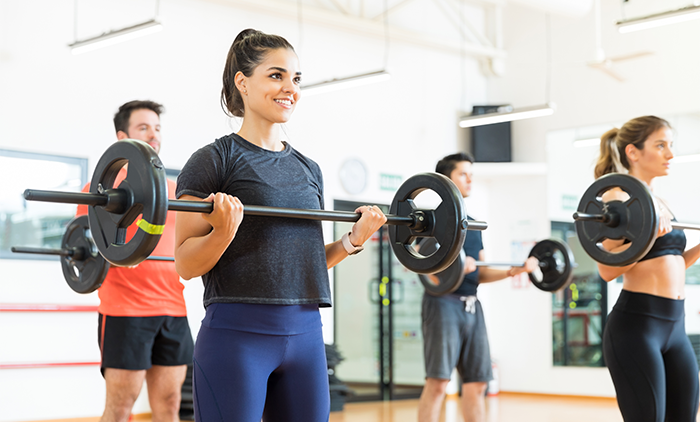
How many calories does HIT burn?
One of the biggest misconceptions about HIT is that it burns more calories.
Here’s the truth…
Yes, working out intensely burns more calories while you’re doing it. But you can’t actually do it for very long, and you need a couple of days to recover.
How many calories does LIT burn?
On the other hand, LIT burns fewer calories than high-intensity exercise on a minute-by-minute basis, but you can sustain the low intensity for much longer.
So, over the week you might end up burning more calories via low-intensity workouts than you do via vigorous exercise.
|
Conclusion Intense exercise burns more calories at the time. But as you can sustain it for less time and do it less often low-intensity may burn more over the long term. |
High-Intensity vs. Low-Intensity Exercise: how often should you do it?
You might think that exercising every day is necessary, but actually, it’s not, nor is it optimum. Especially if you are incorporating vigorous exercise into your routine.
How often should you do a HIT workout?
A HIT workout should feel hard, like an 8 out of 10 on your personal scale of intensity. That will be different for everyone, of course, but the impact on your central nervous system, muscles, and ability to recover will be the same as anyone else.
High-intensity exercise has a lot of benefits, but you need to factor in recovery. It’s not realistic to try and do high-intensity training every day or even several times a week.
If you think you’d like to introduce vigorous exercise into your workout routine then start with two a week and add one more if you are recovering well and feeling good.

How often should you do a LIT workout?
Low-intensity workouts require a lot less recovery time, and you may even be able to incorporate some into your daily routine ie. go a walk with the pram.
If you’re taking dedicated time out of your day to do a low-intensity workout then it will take a little longer, so you’ll need to figure out what is sustainable for your life - and what you will be able to achieve.
Can you combine high and low-intensity workouts?
There’s no right or wrong way to design an exercise routine. After all, the best form of exercise is the one you’ll do consistently! And enjoyment is a big factor in being consistent. It’s really important that you settle on a combination of high and low-intensity exercise that suits your lifestyle, your routine, your injury risk, and what you enjoy doing.
We think the four most important elements in any exercise routine are:
- everyday activity (like walking)
- low-intensity exercise
- high-intensity exercise
- stretching or mobility
The CDC recommends that you get 150 minutes of physical activity per week, and this ideally will be a combination of different activities and intensities as this allows you to sustain a routine.
We recommend keeping active via walking, stretching, or mobility work three times a week for 10 minutes. This is a form of active recovery, which keeps you focused on movement. Then you can divide your dedicated workout time between to
- 60% low intensity
- 40% high intensity
That’s a great place to start and see how you feel.
If you hit a training plateau, it’s time to manipulate one of those exercise variables (duration, load, volume, and intensity).
|
Conclusion Try a combination of both high and low-intensity workouts so that you get the benefits of both and create a sustainable exercise program |
How to introduce high-intensity workouts to your routine
If you’re just getting into exercise, you might worry that high-intensity exercise is too risky for you. Firstly, remember that intensity is subjective, and you don’t have to match anyone else’s effort.
High-intensity workouts are a great way to boost your fitness by giving your body a big stimulus. If you only ever do low-intensity workouts, it will take longer for your body to get fitter and stronger.
Start by making one of your workouts per week high intensity, and keep it at a 7-8 out of 10 effort for you.
High-intensity sessions shouldn’t be long, so push yourself for 5-10 minutes and see how you feel. You’ll be surprised at what you can achieve!
High-intensity Exercise vs Low-Intensity Exercise: which is best for you?
With exercise, there really is no one size fits all, it’s about finding what is right for you. And that’s okay, we’ve all got to be honest about our own limitations and take them into consideration when planning out exercise programs.
It’s also important to think about what you enjoy!
We know that enjoyment and exercise don’t often go in the same sentence, but if you HATE your workouts you’ll not commit to them, and the couch will look more enticing than ever. It’s about finding a sustainable way to increase your exercise over the long term.
This usually means combining high and low-intensity exercises in a way that pushes you to achieve your goals, while remaining suitable and sustainable for your lifestyle. Intense exercise will improve cardio fitness, and many health markers (such as blood pressure and cholesterol) and burn calories faster. But alternating with gentler exercise will allow you to sustain your routine for longer periods, having a positive impact over time.
If you want to find out more about some exercises to introduce to your routine then you can read more here:
Plyometrics exercises: The hard-hitting workout you’ve forgotten about
